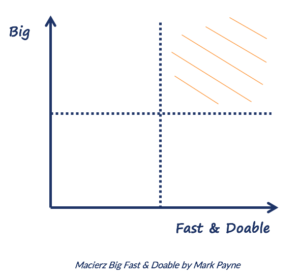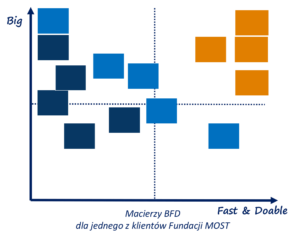
Are you thinking about new ideas, e.g. for a business? Or maybe you are already developing one of them and wondering what to do next, which direction to take? Do you have a few, a dozen, or several dozen ideas? It is not always possible or reasonable to implement all of them. The multitude of possibilities can be overwhelming and block further action. Which of these possibilities should you choose? Which options should you select? This article discusses these issues.
The tool that helps answer these questions is the Big Fast & Doable (BFD) matrix, which is part of the Money & Magic approach proposed by Mark Payne in his book How to Kill a Unicorn. The matrix is an integral part of the workshops we run for entrepreneurs at @Fundacja MOST. This tool works great when working on new products and directions for company development.
The BFD matrix has two axes. The vertical axis determines how Big a given innovation/option/idea is, i.e. how big its potential is, how large and attractive the target group is, how promising the idea is for the organisation’s development, etc. The horizontal axis, on the other hand, shows how Fast & Doable a given innovation/idea is, i.e. it allows us to determine how quickly we are able to realise and implement it, taking into account our limitations, such as the scale of our current responsibilities, lack of appropriate know-how, limited project team, budget, etc. The advantage of the matrix is that we can determine the criteria that make an idea ‘great’ and the criteria that determine its feasibility in a short period of time.

After the brainstorming stage, i.e. the stage of defining possible ideas, we analyse them taking into account two factors, namely those described above: their potential and feasibility, and then we place all the ideas on a matrix.

The most promising and feasible ideas will appear in the upper right quadrant. Their implementation is justified because they have great potential and can be brought to market/implemented relatively quickly. Ideas that appear in other quadrants should be postponed or abandoned – the BFD matrix therefore allows us not only to select the best ideas, but also to arrange the order in which the selected options will be implemented.
The analysis of ideas is very interesting and valuable if several people or even several interdisciplinary teams work on it. Opinions on the potential of the analysed options and the feasibility of their implementation can then vary greatly. Discussing why each participant in the exercise placed the analysed idea in a specific place on the matrix makes it easy to gather all the arguments for and against each idea and justify the final choice.
I encourage you to use this tool whenever the multitude of options and ideas prevents you from making the right decision, or when you want to rank them in the right order.
If you are developing technological products and would like to work with us, i.e. the advisors at @Fundacja MOST, to carry out this exercise and work together on the development opportunities for your projects/products, please contact us. Our network of advisors includes dozens of experts representing various industries and specialising in different areas of business consulting. We will be happy to invite selected experts to participate in the implementation of your projects.
Have you already used the Big, Fast & Doable matrix? Let us know how this tool worked in your projects.